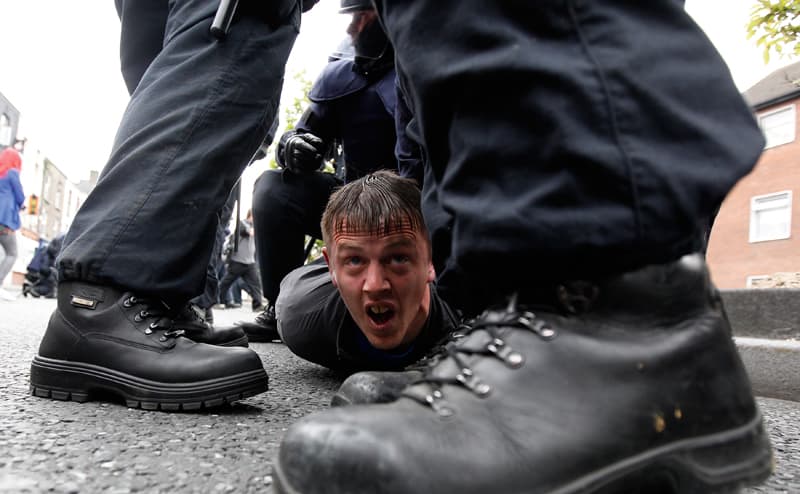Photo Insight with Cathal McNaughton

Award-winning Cathal McNaughton has more than ten years’ experience covering conflicts and breaking news for national newspapers and international press agencies. He shares his best press photographs and reveals how he captures a subject in ways that others haven’t seen
I took this image while covering the Queen and Duke of Edinburgh’s four-day visit to the Republic of Ireland in May last year. It was the first time a British head of state had visited the country since George V 100 years ago. Security was extremely tight because of the sensitive nature of the visit. Protests were expected and, of course, protesters didn’t disappoint.
As it was such a huge event, there was a team of photographers covering what was going on. It would have been impossible to be in all places at the same time – one photographer just couldn’t cover everything. In our immediate team, we had four or five photographers. I’m used to covering civil unrest, especially in Ireland, and I know the layout of the areas around Dublin where things might happen, so it made sense for me to keep an eye on trouble that might be brewing outside the police cordon. My job was to photograph on the periphery and respond if trouble broke out.
The Queen’s schedule was very tight and she was moving in a convoy from one location to the next. Consequently, I had to choose one or two engagements to cover. One especially historic event was the laying of a wreath at the Garden of Remembrance in Dublin. The garden was created to honour those who have been killed fighting for Irish freedom. I knew that if there were going to be any trouble, it was likely to occur around the laying of the wreath.
You can’t go into a situation like this with any preconceived ideas – all you can do is stay alert and respond as events unfold. Demonstrations are very organic, as a protest might start at one point and very quickly end up somewhere else. You have to keep your ear to the ground and notice what’s happening. Keeping in contact with other journalists is one way of staying informed about what’s happening elsewhere.
There were various people being arrested for throwing objects, setting bins on fire and so on, and this was one of those incidents. The police had run after the man and arrested him. It was a case of following the action from the point where the police ran after him to when they caught him and wrestled him to the ground. I actually have a series of images showing what happened leading up to this image and what came afterwards, but this image turned out to be the one that worked best.

As you can see, I took this shot from a low angle. I had to lie on the ground beside the man to photograph him, otherwise his face wouldn’t have been visible. I had no choice but to get down low and look into his eyes. I was using a 16-35mm lens with my Canon EOS 5D Mark III camera. I would probably have been shooting at 16mm and would have been able to touch the guy
with my hand.
To take a photograph like this, you’re putting yourself in harm’s way. It was a tense situation and I could have been trampled on – the police and protesters weren’t thinking about me being there on the ground. In light of this, I got down, took the shots I needed and got out. As you can see from the policeman’s foot, I could have ended up with a broken camera or a broken nose.
There is a love-hate relationship between the police and photographers, and it can go through both these stages very quickly. One minute, the police might not mind you being there, but the next they do mind, so you constantly have to read the situation to gauge the atmosphere. You also have to know your rights, as a person as well as a photographer, and remember that the police are not above the law. In these heated situations, even members of the security forces can get things wrong. Just because someone tells you to do something, you don’t necessarily have to do it. Commonsense has to prevail – you might be allowed to photograph something, but that doesn’t automatically mean it is safe to do so.
When there is so much going on around you, the most important thing is to keep your head and retain your focus. The problem is that whenever there is trouble, it tends to be very sporadic. You can’t afford to get caught up in the moment and run around like a headless chicken – if you do, when it comes to looking at and filing your images, you may find you haven’t really photographed anything at all. Learning to focus on one thing at a time is one of the key skills to develop when covering public disturbances. You have to be very methodical in your approach and pick specific incidents to photograph.
Cathal McNaughton was talking to Gemma Padley
To see more images by Cathal or to book a place on one of his workshops, visit www.cathalmcnaughton.com
To take part in one of our free street photography Masterclasses with Cathal, please send an email with your name, address, telephone number and a couple of sentences about your photographic interests and experience to oliver_atwell@ipcmedia.com








